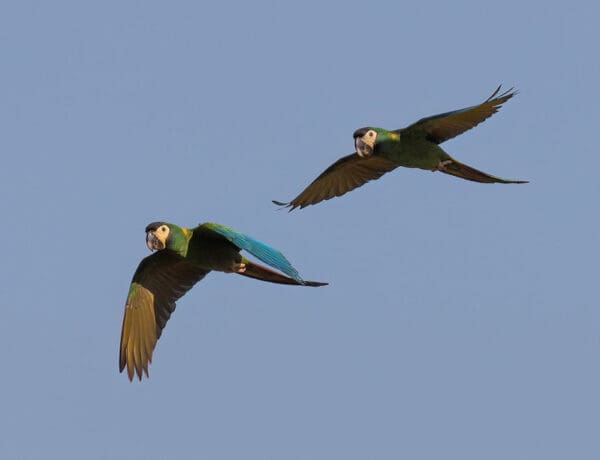Yellow-collared Macaw
Also known as:
Golden-collared Macaw, Yellow-naped Macaw, Golden-naped Macaw, Cassin's Macaw
Also known as:
Golden-collared Macaw, Yellow-naped Macaw, Golden-naped Macaw, Cassin's Macaw

![© Bernard DUPONT [CC BY-SA 2.0] via Flickr A wild Yellow-collared Macaw perches on a limb](https://parrots.org/wp-content/uploads/2023/01/wpt_Yellow-collared-Macaw_1302-20-100x100.jpg)
![© Bernard DUPONT [CC BY-SA 2.0] via Flickr A wild Yellow-collared Macaw dangles from a tree trunk](https://parrots.org/wp-content/uploads/2023/01/wpt_Yellow-collared-Macaw_1302-19-100x100.jpg)







![© Bernard DUPONT [CC BY-SA 2.0] via Flickr A wild Yellow-collared Macaw perches on a branch](https://parrots.org/wp-content/uploads/2023/01/Yellow-collared-Macaw-100x100.jpg)

DID YOU KNOW?
The Yellow-collared Macaw, unlike other parrot species, seems to tolerate extensive habitat change and remains common in some areas.

Primolius

auricollis
Size:
38 cm (14.8 in)
Weight:
250 g (8.75 oz)
Subspecies including nominate:
one
Colour Adult:
Both adults mostly green plumage; brown/black forehead, crown and lower cheeks; yellow collar around hindneck; tail blue with brown/red towards base. Beak grey/black with horn-coloured tip; white/cream bare face. Eye orange.
Colour Juvenile:
As in adults but with grey/white beak and grey eyes.
Call:
Calls in flight loud and gull-like, and also notes resembling Aratinga sp. conures.
More Information:
Content Sources:
CITES
BirdLife International
Cornell Lab of Ornithology/Birds of the World
A Guide to Parrots of the World, Juniper and Parr, 1998
Parrots of the World, Forshaw, 2006. 2010 edition
Parrots in Aviculture, Low, 1992.
Psittacine Aviculture, Schubot, Clubb and Clubb, 1988.
Avian Pediatric Seminar Proceedings, various authors, 1988.
Captive Status:
Common and frequently bred in the US; less so elsewhere.
Longevity:
Up to 50 yrs.
Housing:
Aviary or suspended cage minimum length 4 m (13.1 ft) or 3 m (9.8 ft) for breeding with access to larger flight for part of year.
Diet:
Dried figs soaked in water a few hours, two or more per bird daily, with one drop of Konakion (Roche) or other vitamin K additive, once daily; fruits forming at least 50 percent of diet; soaked sultanas; berries (elder, mountain ash, pyracantha); spray millet; small seed mix with: canary, oats, safflower; cooked pulses; rearing food with: hard-boiled egg, wholegrain bread and carrot, all ground to crumbly consistency; for breeding: live food (mealworms) if taken; commercial insectivorous food; variety of vegetables; walnuts; complete pellet.
Enrichment:
Loves bathing, socialization; needs large, roomy cage; different sized perches; fir, pine, willow or elder chewable branches; ropes, swings, ladders, puzzle toys, bird-safe chewable toys (vegetable tanned leather and wood blocks).
Nest Box Size:
Vertical box 12″ x 12″ x 24″ (30.5 cm x 30.5 cm x 61 cm).
Clutch Size:
3 or 4
Fledging Age:
10 weeks
Hatch Weight:
—
Peak Weight:
—
Weaning Weight:
—
World Population:
Unknown but described as fairly common. Increasing.
IUCN Red List Status:
Least Concern
CITES Listing:
Appendix II
Threat Summary:
Not globally threatened. Fairly common and ecologically adaptable. Previously some concern over trade levels, which by the late 1970s had reached thousands annually. Despite a ban in 1984 illegal trade continues. Has declined at edges of range in Paraguay.
Range:
Found in N and E Bolivia to SW Mato Grosso, Brazil, and N Paraguay to NW Argentina; also Ilha do Bananal in W Goias, NE Mato Grosso and deep SE Para.
Habitat:
Occurs in variety of habitats such as forest, forest edge, woodland and savanna; moist upper tropical and subtropical forest in Argentina, dry forest in Bolivia, chaco in Paraguay and pantanal, open cerrado and gallery forest in Brazil. Up to 600 m (1968 ft), in some areas 1700 m (5576 ft).
Wild Diet:
Eats fruits, flowers, maize and seeds.
Ecology and Behaviour:
Seen in pairs or small groups (outside breeding season). Large flocks where food abundant, and at roosts. Occasionally feeds on the ground.
Clutch and Egg Size:
3 or 4 eggs.
Breeding Season:
December, Argentina. Nest is in tree hollow.
Related Links:
—











